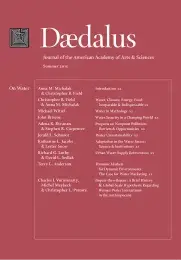A Brief History & Global-Scale Hypothesis Regarding Human-Water Interactions in the Anthropocene
Water is an essential building block of the Earth system and a nonsubstitutable resource upon which humankind must depend. But a growing body of evidence shows that freshwater faces a pandemic array of challenges. Today we can observe a globally significant but collectively unorganized approach to addressing them. Under modern water management schemes, impairment accumulates with increasing wealth but is then remedied by costly, after-the-fact technological investments. This strategy of treating symptoms rather than underlying causes is practiced widely across rich countries but leaves poor nations and many of the world’s freshwater life-forms at risk. The seeds of this modern “impair-then-repair” mentality for water management were planted long ago, yet the wisdom of our “water traditions” may be ill-suited to an increasingly crowded planet. Focusing on rivers, which collectively satisfy the bulk of the world’s freshwater needs, this essay explores the past, present, and possible future of human-water interactions. We conclude by presenting the impair-then-repair paradigm as a testable, global-scale hypothesis with the aim of stimulating not only systematic study of the impairment process but also the search for innovative solutions. Such an endeavor must unite and cobalance perspectives from the natural sciences and the humanities.
Greenhouse warming and potential changes to the hydrologic cycle figure prominently in the climate-change debate, but many other direct anthropogenic factors are today redefining the state of rivers, which supply around 80 percent of renewable freshwater to society.1 Chief among these are widespread land-use change, urbanization, industrialization, and pollution, all known to stress aquatic ecosystems. The highly positive impacts of a reliable water supply on economic productivity (which requires waterworks like dams, irrigation, and interbasin transfers), means that the water cycle will increasingly be controlled by humans for decades if not centuries to come, a hallmark of the new geological epoch called the Anthropocene.2 With human control of water also comes the specter of water conflict, an issue emphasized by several high-profile research studies, including the last rounds of the Intergovernmental Panel on Climate Change (IPCC), the U.S. National Climate Assessment, and the National Intelligence Estimate.
Water crises are not restricted to humans alone. Freshwater ecosystems are critical biodiversity hotspots. Occupying less than 1 percent of the Earth’s surface, they provide habitat to more than 125,000 cataloged species and one-third of all vertebrates and affiliated taxa.3 Their restricted spatial extent belies their importance, as they maintain orders of magnitude more species per unit area than their terrestrial or oceanic counterparts. The intimate connection and importance of rivers, lakes, and wetlands to human society, coupled with mismanagement, pollution, and climate change, produces the highest potential loss of species on the planet. By some estimates, between ten and twenty thousand species have been lost to date.4
Their current stress notwithstanding, water systems will be relied upon over the next several decades to deliver reliable services in light of anticipated economic development and population growth.5 We refer here to ecosystem services, the array of public goods and functions that nature conveys and which will in the long term sustain human society. These include provisioning benefits like clean drinking water, navigation, waste dilution, transportation, food, and energy production. Ecosystem services also include important regulatory functions (such as climate control) and supporting functions of the biosphere (such as the cycling of essential nutrients). While the value of all these services is subject to debate, they likely make possible a sizable but poorly quantified fraction of global GDP.6 Despite their clear importance, a survey of the world’s major biomes at the turn of the century shows that in virtually all cases “natural capital” is being actively lost, degraded, or co-opted by humans.7 It remains an open question how available and capable such services will be to serve the water needs of society over the long haul.8 The answer concerns an issue no less important than how we humans place the planet’s sustainability–and our own water security–in the balance. For freshwater, the preliminary outlook is sobering.
. . .
